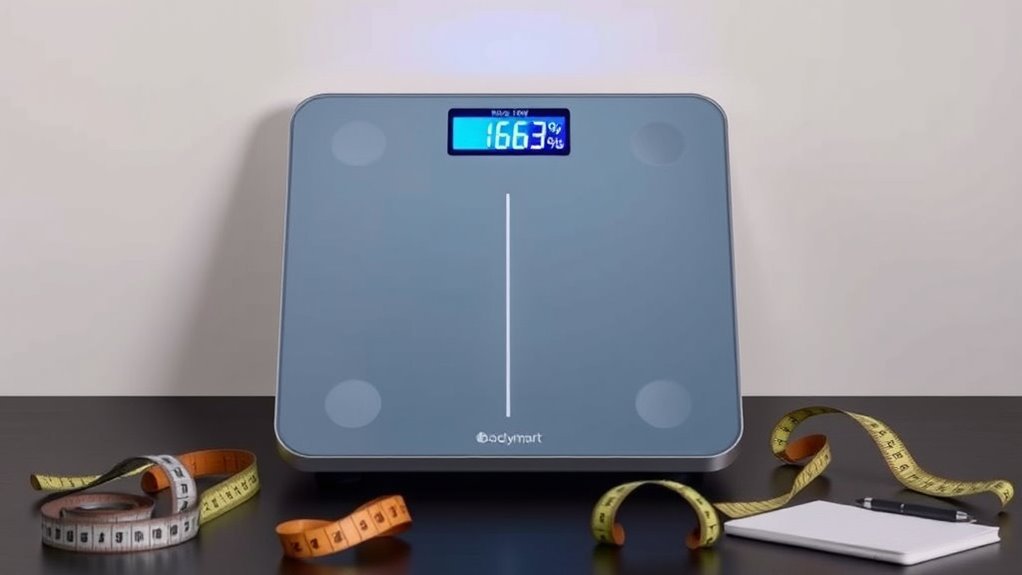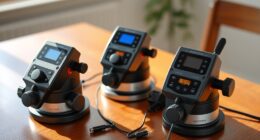Smart scales track essential body metrics like body fat percentage, muscle mass, and hydration levels. They use bioelectrical impedance technology, sending tiny electrical currents through your body to assess tissue resistance. This gives you insights beyond just your weight, helping you understand your overall body composition better. However, keep in mind that factors like hydration and foot positioning can affect accuracy. Discover more about how these scales work and their limitations ahead.
Key Takeaways
- Smart scales primarily track body weight, displaying it in kilograms or pounds upon use.
- They measure body fat percentage, indicating potential health risks above 25% for men and 32% for women.
- Smart scales also assess muscle mass, providing insights into overall body composition beyond weight alone.
- Additional metrics tracked include hydration levels, which help gauge body water content and overall health.
- Regular use supports health goals by showing trends in body composition and emphasizing the importance of balanced nutrition.
Understanding Smart Scales and Their Functionality

As you explore the world of smart scales, you’ll find they offer more than just a simple weight measurement.
These innovative devices utilize bioelectrical impedance to estimate body composition metrics, including body fat percentage, muscle mass, and hydration levels. By sending imperceptible electrical currents through your body, smart scales measure the resistance those currents encounter. Different tissues, such as fat and muscle, react differently due to their water content, allowing for insightful estimates. Maintaining a balanced nutritional intake is essential for supporting overall body composition and health. Additionally, regular monitoring of preventive care can help you identify potential health issues early on. To further enhance your health, consider the role of gout nutrition as dietary choices can significantly impact your body composition.
Many smart scales connect to smartphone apps, helping you track your weight management journey over time. However, keep in mind that the accuracy of these readings can vary based on foot size, moisture, and user positioning, so consistent usage under similar conditions is key for reliable results. Additionally, maintaining hydration levels is crucial for accurate impedance measurements, as water content in the body influences the readings.
Key Metrics Measured by Smart Scales

When you step on a smart scale, you’ll first see your body weight measurement, a key indicator of your overall health.
But it doesn’t stop there; these scales also provide insights into your body fat percentage, helping you understand your body composition better. Additionally, many smart scales can track essential body metrics such as muscle mass and water percentage, giving you a more comprehensive view of your health. Incorporating measurements like protein intake can further guide your fitness journey and health choices. Furthermore, understanding how to manage competition in any business, including health-related products, can enhance your approach to wellness. Additionally, some smart scales offer integration with smart home devices, allowing for seamless tracking and enhanced user experience. Regularly monitoring your body composition metrics can help you stay on track with your health goals.
Body Weight Measurement
Smart scales offer a thorough approach to body weight measurement, giving you more than just your weight in kilograms or pounds. They provide a direct evaluation of your body weight while also displaying your BMI, which relates your weight to height and helps categorize your weight status.
Additionally, many smart scales estimate body fat percentage using bioelectrical impedance, gauging the proportion of fat in relation to your total body weight. You can also track your lean mass, which indicates the amount of muscle tissue in your body, essential for understanding overall body composition. This understanding can enhance your emotional resilience, aiding in coping with challenges related to health and wellness. Moreover, regular tracking of air quality improvement through air purifiers can complement your health goals by ensuring a healthier living environment. It’s important to note that maintaining a balanced diet during weight tracking can help support your detoxification process, leading to better overall health outcomes.
Furthermore, the focus on eco-friendly materials in health-related devices can contribute to a sustainable lifestyle, aligning with broader wellness objectives.
Plus, these devices frequently measure hydration levels, giving you insights into your body’s water content that can affect weight and health. Understanding financial metrics can also help you make informed decisions about your health investments and wellness goals.
Body Fat Percentage
Body fat percentage is an essential metric that smart scales provide, helping you understand your body composition beyond just weight.
Smart scales use bioelectrical impedance to estimate body fat, but keep in mind that various factors can affect accuracy. Additionally, understanding required minimum distributions can help you better plan for your financial health as you monitor your physical health. Alimony types can also play a role in financial planning during life changes. Research has shown that pet therapy can enhance emotional well-being, similar to how tracking body composition can improve motivation and mental health in fitness journeys. Engaging in regular physical activity can also significantly impact your body fat percentage and overall health.
- Hydration levels can influence your readings.
- Foot position matters for consistent measurements.
- Regular tracking can show your fitness progress over time.
- A body fat percentage of 25% or higher for men and 32% or higher for women may indicate health risks.
While these scales are convenient for gauging overall health, remember they offer rough estimates. Additionally, maintaining a balanced nutrition approach is crucial for overall fitness and can impact body composition.
For precise measurements, consider methods like DEXA scans.
Embrace the journey of weight loss and monitor changes in body fat percentage for better insights!
How Smart Scales Use Bioelectrical Impedance

To measure body composition effectively, smart scales utilize bioelectrical impedance analysis (BIA), which sends a low-level electrical current through your body.
This current encounters resistance that varies by tissue type, helping body fat scales estimate metrics like body fat percentage, lean body mass, and total body water. Regular maintenance of your smart scale, including filter replacement when necessary, can ensure accurate readings over time. Additionally, the use of self-watering planters can promote consistent plant hydration, similar to how smart scales ensure consistent health metric monitoring. Understanding how audiometric testing works is crucial for accurately diagnosing hearing-related issues, just as smart scales provide precise body composition analysis. Furthermore, maintaining indoor air quality is essential for overall health, as it can impact your physical well-being.
The principle behind BIA is simple: fat tissue has a lower water content and higher resistance compared to lean tissues.
Using foot-to-foot bio-electrical technology, these scales provide a non-invasive way to assess your body composition at home. When you step on the scale, it can measure your body fat and give you insights into your health and fitness journey, making it a useful tool for anyone looking to improve their well-being. Additionally, skincare routines that incorporate hydration can enhance the appearance of your skin, complementing your overall health metrics.
Accuracy of Smart Scale Measurements

When using smart scales, you might notice variability in your measurements due to factors like hydration and posture.
While they provide a general idea of your body composition, smart scales can’t match the accuracy of professional methods like DEXA scans.
Understanding these limitations can help you interpret your readings more effectively.
Measurement Variability Factors
While smart scales offer a convenient way to track body composition, several factors can impact the accuracy of their measurements.
Understanding these variability factors can help you get more accurate readings regarding body fat distribution.
- Foot size and width affect impedance measurements.
- User posture and position on the scale can lead to inconsistent results.
- Moisture from sweat on your feet can interfere with electrical signals.
- User practices such as consistent measurement conditions and timing are essential.
Accuracy Compared to DEXA
Although smart scales provide a convenient way to monitor your body composition, their accuracy pales in comparison to DEXA scans, which are the gold standard for measuring body fat and lean mass.
Smart scales typically use bioelectrical impedance analysis (BIA) to estimate body fat percentage, but they often overestimate fat levels in lean individuals and underestimate them in those with higher fat levels. This variability makes it tough to trust their readings.
DEXA scans, on the other hand, offer precise measurements of body fat, fat-free mass, and even bone density.
While you can use smart scales to measure your weight and track trends, for accurate body composition analysis, consulting professional assessments like DEXA is highly recommended.
Limitations of Smart Scales in Body Composition Analysis

Smart scales, despite their popularity and convenience, have several limitations when it comes to body composition analysis. They primarily use bioelectrical impedance to estimate body fat percentage, but this method isn’t precise due to individual variability.
Smart scales offer convenience but lack precision in body composition analysis due to individual variability in bioelectrical impedance.
Here are some key limitations you should consider:
- They can’t accurately measure visceral fat, which poses health risks.
- Bone density assessment is absent, leaving gaps in your overall body composition understanding.
- Lean mass and muscle mass imbalances aren’t effectively evaluated, leading to potential misinterpretations.
- Factors like hydration levels, foot size, and positioning can skew accuracy.
Alternatives to Smart Scales for Tracking Body Composition
If you’re seeking more accurate methods for tracking body composition, several alternatives to smart scales can provide valuable insights.
DEXA scans are the gold standard, offering detailed assessments of body fat, lean mass, and bone density. For a more accessible option, skinfold calipers estimate body fat by measuring skinfold thickness, although accuracy relies on the practitioner’s skill.
Bioelectrical impedance devices can give you estimates of body fat percentage, but they’re less precise than DEXA scans. You might also consider waist circumference measurements, which can indicate abdominal fat levels and related health risks.
Finally, while underwater weighing and Bod Pods are accurate for measuring body fat, they may not be readily available. Exploring these options can enhance your understanding of your body composition.
Frequently Asked Questions
What Do Smart Scales Measure?
Smart scales measure a variety of metrics that help you understand your body composition. You’ll typically see your body weight, body fat percentage, lean mass, and water content displayed.
Many models also track visceral fat, skeletal muscle mass, and metabolic age. These measurements use bioelectrical impedance analysis, providing estimates that can vary based on hydration and body composition.
Is 20% Body Fat Acceptable?
Is 20% body fat acceptable? It can be both a marker of fitness and a risk if you’re not careful.
For men and women, 20% falls within the healthy range. You may look lean, yet still have enough fat for energy and hormones.
What Are the Disadvantages of Smart Scales?
Smart scales come with several disadvantages.
They often provide inaccurate body fat percentages due to factors like hydration levels and your positioning during measurements. You might also notice fluctuations in readings based on the time of day or recent meals, which can confuse your tracking efforts.
Additionally, their reliance on bioelectrical impedance analysis means they may not effectively measure visceral fat or give you a clear picture of fat distribution.
How Accurate Are Withings Smart Scales?
Withings smart scales offer a range of body composition readings, but their accuracy for body fat percentage can vary.
You might find that they don’t match the precision of professional tools like DEXA scans. Factors like your hydration levels and foot position can influence the results, so consistency in measurement conditions is essential.
While they effectively track trends over time, daily fluctuations can still occur, so keep that in mind when interpreting your data.
Conclusion
In conclusion, smart scales serve as savvy solutions for tracking your body metrics, measuring more than just weight. While they present a plethora of potential stats—from body fat to muscle mass—remember their limitations. These devices deliver dazzling data, but accuracy can sometimes waver. So, if you’re seeking a complete picture of your health, consider complementary methods. Ultimately, being informed empowers you to navigate your wellness journey with confidence and clarity, ensuring you stay on track toward your goals.









